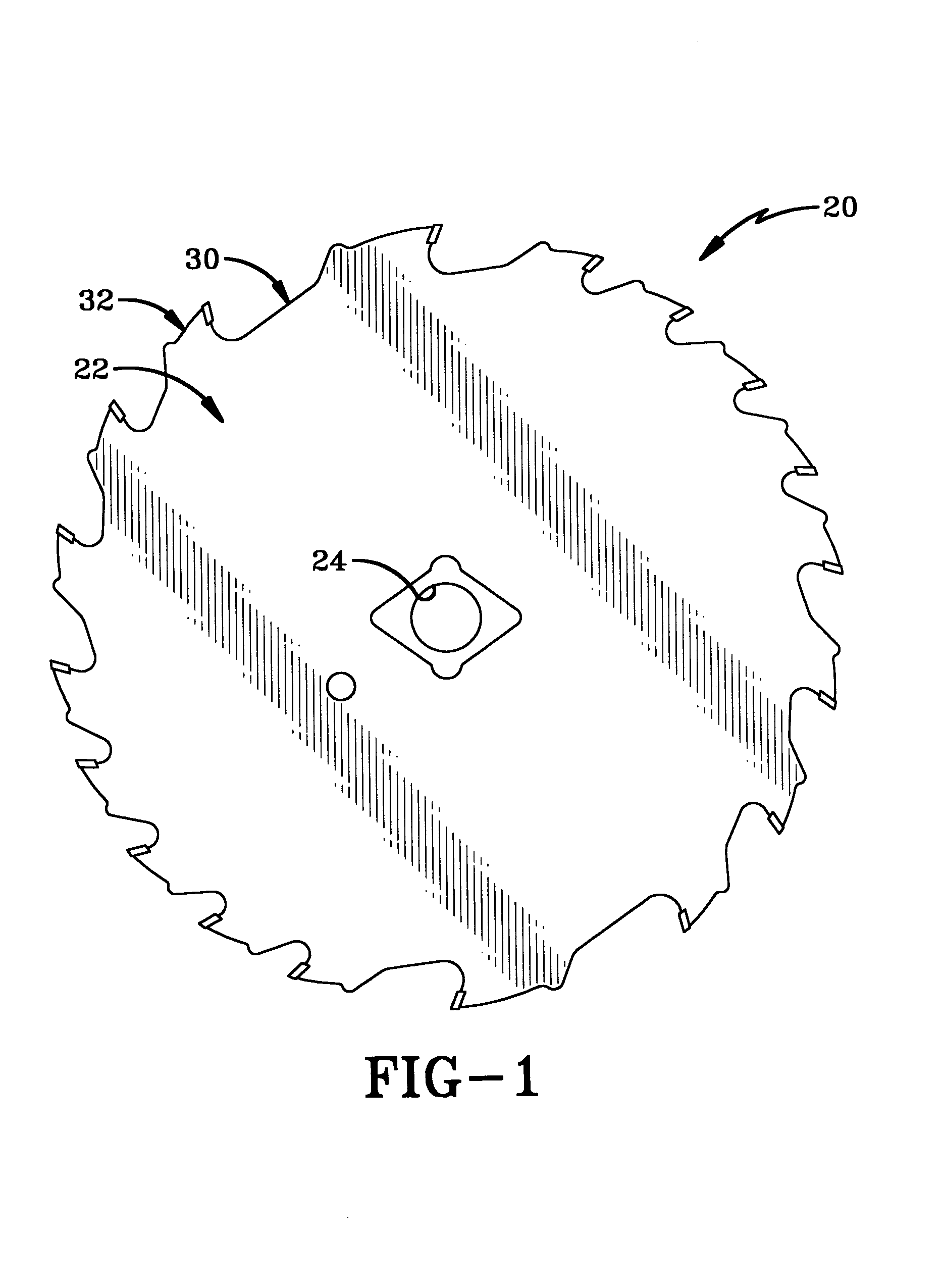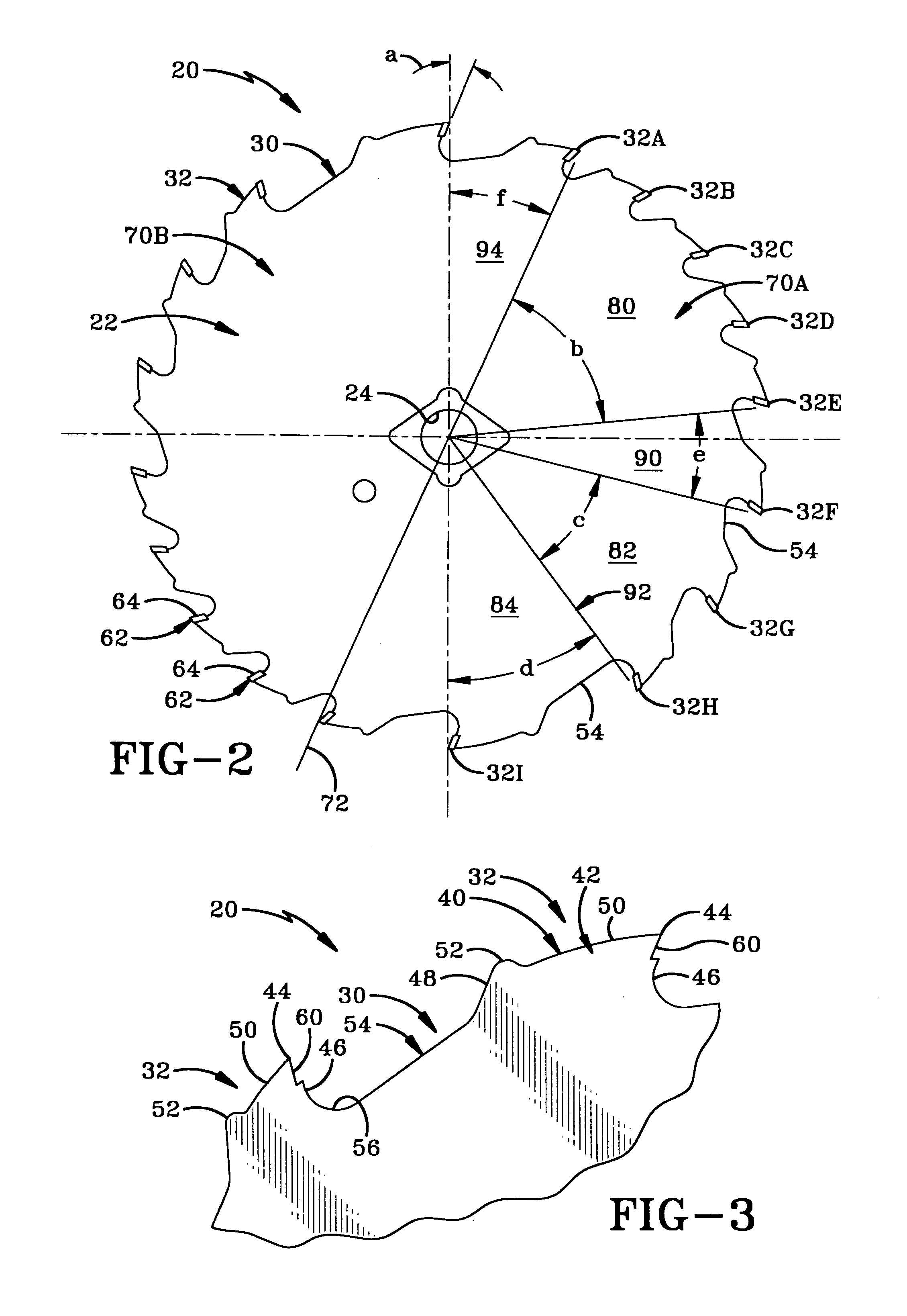Variable tooth saw blade
a technology of tooth saw blades and variable blades, which is applied in the field of variable blades, can solve the problems of excessive noise and less than desirable cuts
- Summary
- Abstract
- Description
- Claims
- Application Information
AI Technical Summary
Problems solved by technology
Method used
Image
Examples
fifth embodiment
[0031]In further accordance with one of the features of the invention, the sections in each half do not have the same number of teeth or teeth of the same size as the other sections. More particularly, there are a different number of cutting edges 44 in each section in each half and the circumferential width between each of the adjacent cutting edges 44 within a given section is different than that of each other section in a given half. Blade 420 of the fifth embodiment is a partial exception to this rule regarding the differing number of teeth or cutting edges from group to group. Specifically, blade 420 includes respectively within its four sections on one half of the blade twelve cutting edges, eight cutting edges, twelve cutting edges and three cutting edges. Thus, while the number of cutting edges (and teeth) within each section changes between adjacent sections, the first and third sections have the same number of cutting edges. However, the size of the teeth in each section o...
second embodiment
[0036]In accordance with yet one more feature of the invention, it has been discovered that alternating the number of teeth or cutting edges in adjacent sections from odd to even provides additional benefits including noise reduction. Blade 120 of the second embodiment is the only blade of those described herein adhering to this pattern. However, it has also been found that noise and vibrations are reduced with blades including at least one section having an even number of cutting edges and at least one section having an odd number of cutting edges.
first embodiment
[0037]In more detail as to the blade referred to as 20, teeth 32 are arranged in a unique eighteen-tooth design that is divided into two copy exact sections, namely a first side 70A and a second side 70B divided by axis 72. Since the blade as shown in FIGS. 1–2 has a right and left copy exact side (sides 70A and 70B respectively), only the right side will be described below (except where necessary to refer to the other or left side where transitions occur). The first side 70A includes nine teeth, namely teeth 32A, 32B, 32C, 32D, 32E, 32F, 32G, 32H, and 321 separated by voids 54.
[0038]In accordance with another feature of the invention, the nine teeth 32A, 32B, 32C, 32D, 32E, 32F, 32G, 32H, and 321 of each side 70A and 70B are not all identical in size and spacing. Specifically in the embodiment shown, first side 70A is divided into three sections 80, 82 and 84 (and thus the saw blade 20 has six sections over sides 70A and 70B) of varying circumferential distance with differing numbe...
PUM
| Property | Measurement | Unit |
|---|---|---|
| hook angle | aaaaa | aaaaa |
| transition angle | aaaaa | aaaaa |
| transition angle | aaaaa | aaaaa |
Abstract
Description
Claims
Application Information
 Login to View More
Login to View More - R&D
- Intellectual Property
- Life Sciences
- Materials
- Tech Scout
- Unparalleled Data Quality
- Higher Quality Content
- 60% Fewer Hallucinations
Browse by: Latest US Patents, China's latest patents, Technical Efficacy Thesaurus, Application Domain, Technology Topic, Popular Technical Reports.
© 2025 PatSnap. All rights reserved.Legal|Privacy policy|Modern Slavery Act Transparency Statement|Sitemap|About US| Contact US: help@patsnap.com



